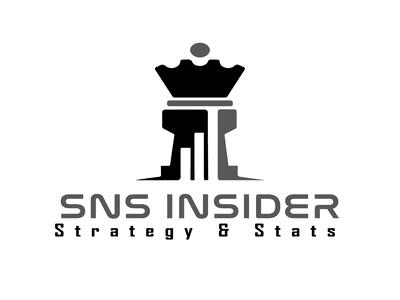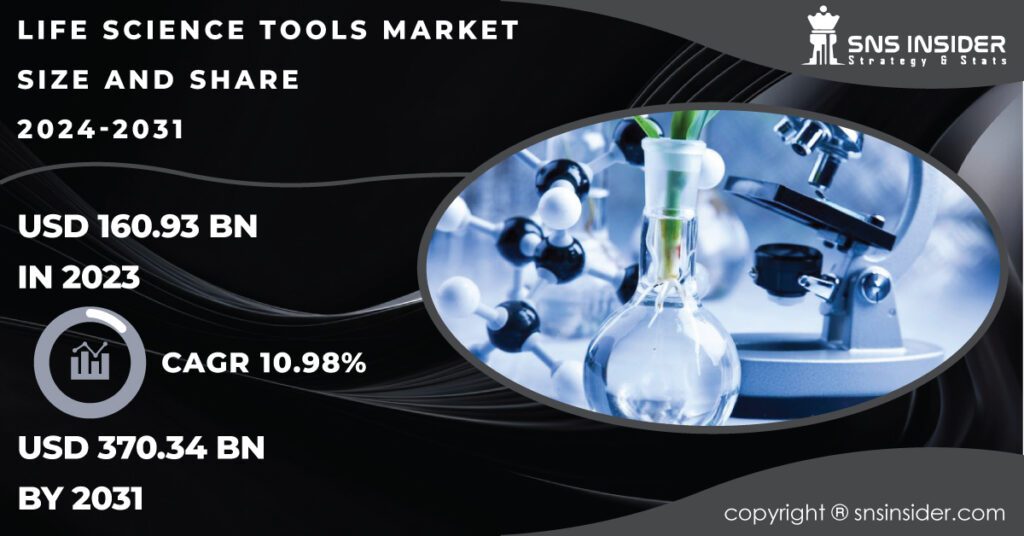
According to SNS Insider, the Life Science Tools Market was valued at USD 160.93 billion in 2023, with projections indicating a robust growth trajectory. Forecasts suggest that by 2031, the market is expected to reach USD 370.34 billion, reflecting a compound annual growth rate (CAGR) of 10.98% during the forecast period of 2024-2031.

Get Free Sample Report of Life Science Tools Market @ https://www.snsinsider.com/sample-request/3833
What are the key factors driving the growth of market?
The growing burden of chronic diseases like cancer and diabetes necessitates the creation of more effective treatments, supporting the need for advanced tools in genomics and cell biology. Furthermore, government support for life science research acts as a significant tailwind, promoting the development of next-generation tools. To stay ahead, key players must prioritize continuous product development, focusing on cost-effective solutions that enhance efficiency and streamline workflows for researchers. By capitalizing on these driving forces and strategically adapting to evolving market needs, life science tool giants can solidify their positions and unlock new avenues for growth.
List of Life Science Tools Companies Profiled in Report:
- Agilent Technologies Inc.
- Becton Dickinson and Company
- Hoffmann-La Roche Ltd.
- Bio-Rad Laboratories Inc.
- Danaher Corporation
- Illumina Inc.
- Thermo Fisher Scientific Inc.
- QIAGEN N.V.
- Merck KGaA
- Siemens Healthineers
- Hitachi Ltd.
- Bruker Corporation
- Oxford Instruments plc
- Zeiss International
- EdiGene
Impact of geopolitical trends on value chain of key players?
The life science tools market, a network of companies crucial for research and development of medicines and diagnostics, isn’t immune to the tremors of geopolitical tensions. Trade restrictions and sanctions can disrupt the flow of essential materials and equipment, impacting companies across the value chain. Smaller players, reliant on specific sources, become especially vulnerable. This can lead to price hikes and shortages, potentially stalling scientific progress. However, these pressures also spark innovation. The need for secure supply chains may push companies to diversify manufacturing bases and source materials from new regions. These geopolitical pressures could reshape the landscape, potentially creating opportunities for geographically strategic players.
Regional Analysis:
The life science tools market exhibits a dynamic regional landscape. North America, currently the dominant region with a market share of approximately 39%% in 2023, boasts a well-established research infrastructure, significant government funding, and the presence of leading life science companies. However, the Asia Pacific region is assured for the fastest growth projected CAGR of 11.97% from 2024 to 2031 due to rising healthcare spending, increasing government investments, and an expanding pharmaceutical industry. Europe, with a mature market and focus on personalized medicine, is expected to maintain a steady growth rate.
Life Science Tools Industry Segmentation as Follows:
By Technology
- Genomic Technology
- Proteomics Technology
- Cell Biology Technology
- Other Analytical & Sample Preparation Technology
- Lab Supplies & Technologies
By Type
- Cell Culture Systems & 3D Cell Culture
- Instruments
- Consumables
- Cell & Tissue Culture Services
- Liquid Chromatography
- Instruments
- Consumables
- Services
- Mass Spectrometry
- Instruments
- Consumables
- Services
- Flow Cytometry
- Instruments
- Consumables
- Services
- Cloning & Genome Engineering
- Kits, Reagents, and Consumables
- Services
- Microscopy & Electron Microscopy
- Instruments
- Consumables
- Services
- Next Generation Sequencing
- Instruments
- Consumables
- Services
- PCR & qPCR
- Instruments
- Consumables
- Services
- Nucleic Acid Preparation
- Instruments
- Consumables
- Services
- Nucleic Acid Microarray
- Instruments
- Consumables
- Services
- Sanger Sequencing
- Instruments
- Consumables
- Services
- Transfection Devices & Gene Delivery Technologies
- Equipment
- Reagents
- NMR
- Instruments
- Consumables
- Services
- Other Separation Technologies
- Instruments
- Consumables
- Services
- Other Products & Services
- Antibodies
- General Supplies
- Others
- Instruments
- Consumables
- Services
By End User
- Government & Academic
- Biopharmaceutical Company
- Healthcare
- Industrial Applications
- Others
Request Sample PDF to See Structure of Report @ https://www.snsinsider.com/sample-request/3833
Segment Analysis:
The life science tools market caters to a diverse range of end users, each with distinct needs. Government and academic institutions utilize these tools for fundamental research, disease surveillance, and public health initiatives. Biopharmaceutical companies are the powerhouses of drug discovery and development, relying heavily on life science tools to accelerate research and clinical trials. The healthcare sector, encompassing hospitals and clinics, leverages these tools for diagnostics, personalized medicine, and improving patient outcomes. Industrial applications extend beyond healthcare, with tools used in agriculture, environmental testing, and biofuel production.
Finally, the “Others” segment captures a wide variety of users, such as contract research organizations and independent laboratories, supporting the broader life science ecosystem. Understanding these diverse end-user segments is crucial for market players to tailor their product offerings and address specific research and development needs.
Social Trends:
The life science tools market is trembling with social trends that influence its trajectory. A rising focus on personalized medicine is driving demand for advanced tools for genetic analysis and biomarker detection. Social media buzz around DIY biology kits and citizen science initiatives highlights a growing public interest in life sciences. This democratization of scientific exploration is nudging companies towards user-friendly tools and open-source data platforms. Furthermore, ethical discussions surrounding gene editing and CRISPR technology are shaping regulatory landscapes and influencing consumer preferences towards ethically sourced tools. By understanding these social currents, life science tool manufacturers can tailor their offerings to a more informed and engaged audience.
Recent Developments:
In 2023, Danaher acquired a leading provider of bioprocessing tools to strengthen its life science portfolio
Thermo Fisher Scientific and Avantor partnered in 2022 to develop integrated solutions for biopharmaceutical manufacturing
Launch of automated workflow solutions, AI-powered analytical tools, and bioprocessing systems by major players
Key Takeaways from the Life Science Tools Market Report:
- Increasing R&D investments by biopharmaceutical companies, rising demand for advanced analytical tools are major growth drivers
- The consumables segment accounted for the largest revenue share in 2023 driven by recurring usage in research and production activities
- North America dominated the market in 2023 owing to well-established life sciences industry, strong academic and research institutes
- Asia Pacific is anticipated to register the highest CAGR from 2024-2031 driven by growth of biotechnology sector, increasing outsourcing activities
Purchase Life Science Tools Market Report @ https://www.snsinsider.com/checkout/3833
Table of Content
Chapter 1 Introduction
Chapter 2 Research Methodology
Chapter 3 Life Science Tools Market Dynamics
Chapter 4 Impact Analysis (COVID-19, Ukraine- Russia war, Ongoing Recession on Major Economies)
Chapter 5 Value Chain Analysis
Chapter 6 Porter’s 5 forces model
Chapter 7 PEST Analysis
Chapter 8 Life Science Tools Market Segmentation, By Technology
Chapter 9 Life Science Tools Market Segmentation, By Type
Chapter 10 Life Science Tools Market Segmentation, By End User
Chapter 11 Regional Analysis
Chapter 12 Company profile
Chapter 13 Competitive Landscape
Chapter 14 Use Case and Best Practices
Chapter 15 Conclusion
Continued…
Have Any Query? Ask Our Experts @ https://www.snsinsider.com/enquiry/3833
About US:
SNS Insider has been a leader in data and analytics globally with its authentic consumer and market insights. The trust of our clients and business partners has always been at the center of who we are as a company. We are a business that leads the industry in innovation, and to support the success of our clients, our highly skilled engineers, consultants, and data scientists have consistently pushed the limits of the industry with innovative methodology and measuring technologies.
We assist our clients to anticipate industrial, economic, and consumer trends to drive disruptive change by fusing global experience with local information from experts throughout the world. We bring context to strategic and tactical data by bridging approaches based on data science and field research, assisting you in addressing your most pressing problems and spotting possibilities.
Contact Us:
Akash Anand – Head of Business Development & Strategy,
[Protected Email],
Phone: +1-415-230-0044 (US) | +91-7798602273 (IND),
Website: https://www.snsinsider.com/

